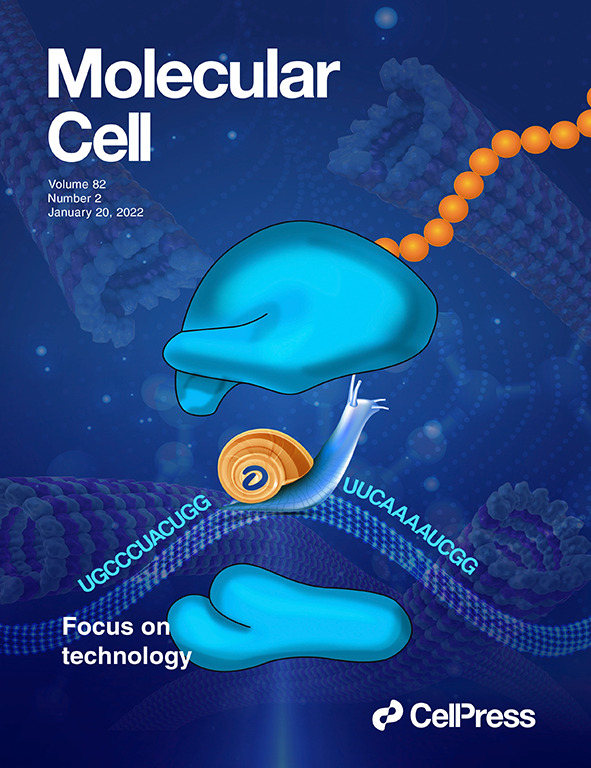ANKS1A缺陷会异常增加蛋白质运输机械进入外膜纤毛的机会
IF 3.7
3区 生物学
Q2 BIOCHEMISTRY & MOLECULAR BIOLOGY
引用次数: 0
摘要
在这项研究中,我们研究了在Ankyrin repeat and SAM domain-containing protein 1A (ANKS1A)缺陷的附膜细胞中,FOP蛋白水平的变化是否会影响多纤毛中的鞘内转运(IFT)蛋白转运系统。在ANKS1A缺陷的附膜细胞的多纤毛中观察到三种明显的异常。首先,缺乏 ANKS1A 的纤毛上有更多的 IFT88 阳性序列。每个离体纤毛的结果也类似。其次,由于缺乏 ANKS1A,每个离体纤毛中的细胞外囊泡(ECV)数量显著增加。第三,纤毛膜蛋白 Van Gogh-like 2(Vangl2)在缺乏 ANKS1A 的细胞中沿着纤毛和附着在纤毛上的细胞外小泡中被大量检测到。我们还利用原代外胚层培养系统获得了从多纤毛释放的ECV。结果我们发现,ANKS1A缺陷细胞的ECV含有更多的IFT机制和Vangl2。这些结果表明,ANKS1A 缺陷增加了进入多纤毛的蛋白质转运机制,由于这些异常的蛋白质转运,沿纤毛形成了过多的 ECV。我们的结论是,附膜细胞利用以ECV为基础的处理系统来清除基底体中过量转运的蛋白质。本文章由计算机程序翻译,如有差异,请以英文原文为准。
ANKS1A-Deficiency Aberrantly Increases the Entry of the Protein Transport Machinery into the Ependymal Cilia
In this study, we examine whether a change in the protein levels for FOP in Ankyrin repeat and SAM domain-containing protein 1A (ANKS1A)-deficient ependymal cells affects the intraflagellar transport (IFT) protein transport system in the multicilia. Three distinct abnormalities are observed in the multicilia of ANKS1A-deficient ependymal cells. First, there were a greater number of IFT88-positive trains along the cilia from ANKS1A deficiency. The results are similar to each isolated cilium as well. Second, each isolated cilium contains a significant increase in the number of extracellular vesicles (ECVs) due to the lack of ANKS1A. Third, Van Gogh-like 2 (Vangl2), a ciliary membrane protein, is abundantly detected along the cilia and in the ECVs attached to them for ANKS1A-deficient cells. We also use primary ependymal culture systems to obtain the ECVs released from the multicilia. Consequently, we find that ECVs from ANKS1A-deficient cells contain more IFT machinery and Vangl2. These results indicate that ANKS1A deficiency increases the entry of the protein transport machinery into the multicilia and as a result of these abnormal protein transports, excessive ECVs form along the cilia. We conclude that ependymal cells make use of the ECV-based disposal system in order to eliminate excessively transported proteins from basal bodies.
求助全文
通过发布文献求助,成功后即可免费获取论文全文。
去求助
来源期刊

Molecules and Cells
生物-生化与分子生物学
CiteScore
6.60
自引率
10.50%
发文量
83
审稿时长
2.3 months
期刊介绍:
Molecules and Cells is an international on-line open-access journal devoted to the advancement and dissemination of fundamental knowledge in molecular and cellular biology. It was launched in 1990 and ISO abbreviation is "Mol. Cells". Reports on a broad range of topics of general interest to molecular and cell biologists are published. It is published on the last day of each month by the Korean Society for Molecular and Cellular Biology.
 求助内容:
求助内容: 应助结果提醒方式:
应助结果提醒方式:


